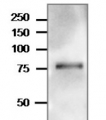1

Anti-TGG2 | Myrosinase 2 ( BGL37)
- Product Info
-
Immunogen: BSA-conjugated peptide, derived from N-terminus of Arabidopsis thaliana TGG2, UniProt: Q9C5C2 , TAIR: At5g25980 Host: Rabbit Clonality: Polyclonal Purity: Total IgG. Protein A purified in PBS, 50% glycerol. Filter sterilized. Format: Liquid at 2 mg/ml. Quantity: 200 µg Storage: Store at -20°C; once reconstituted make aliquots to avoid repeated freeze-thaw cycles. Please remember to spin the tubes briefly prior to opening them to avoid any losses that might occur from material adhering to the cap or sides of the tube. Tested applications: ELISA (ELISA), Immunolocalisation (IL), Western blot (WB) Recommended dilution: assay dependent (ELISA), (IL), 1: 1000 (WB) Expected | apparent MW: 63 | 70 kDa - Reactivity
-
Confirmed reactivity: Arabidopsis thaliana Predicted reactivity: Species of your interest not listed? Contact us Not reactive in: No confirmed exceptions from predicted reactivity are currently known - Application Examples
-

Arabidopsis thaliana crude leaf was freshly extracted with 2x SDS-sample buffer (+ 2ME) for SDS-PAGE and denatured with 4X SDS buffer at 95°C for 5 min. Protein was loaded and separated on 15-20 % SDS-PAGE and blotted 1h to PVDF membrane. Blot was blocked with 3 % skim milk/TBS-T, 1h/RT with agitation. Blot was incubated in the primary antibody at a dilution of 1: 1000 in TBS-T for 1h/RT. The antibody solution was decanted and the blot was washed 4 times for 10 min in TBS-T at RT with agitation. Blot was incubated in matching secondary antibody (anti-rabbit IgG horse radish peroxidase conjugated) diluted to 1:10 000 in for 1h/RT with agitation. The blot was washed as above and developed with a chemiluminescent detection reagent, following manufacture's recommendations.
This antibody does not recognize Arabidopsis thaliana TGG1.
- Additional Information
-
Additional information (application): Signal peptide of 28 amino acids is removed from N-termins. Three glycosylation sites were identified in the mature form of the protein.
Antibody specificity has been confirmed using wild-type and tgg2-1 mutant Ueda et al. (2006). - Background
-
Background: TGG2 | Myrosinase 2 ( BGL37) may degrade glucosinolates (glucose residue linked by a thioglucoside bound to an amino acid derivative) to glucose, sulfate and any of the products: thiocyanates, isothiocyanates, nitriles, epithionitriles or oxazolidine-2-thiones. These toxic degradation products can deter insect herbivores. Seems to function in abscisic acid (ABA) and methyl jasmonate (MeJA) signaling in guard cells. Functionally redundant with TGG1. Cellular localisation: vacuole.
Alternative names: Beta-glucosidase 37, AtBGLU37, Sinigrinase 2, Thioglucosidase 2. - Product Citations
-
Selected references: Liebminger et al. (2012). Myrosinases TGG1 and TGG2 from Arabidopsis thaliana contain exclusively oligomannosidic N-glycans. Phytochemistry. 2012 Dec;84(21):24-30.doi: 10.1016/j.phytochem.2012.08.023. (Western blot)
Shirakava et al. (2010). Arabidopsis Qa-SNARE SYP2 proteins localized to different subcellular regions function redundantly in vacuolar protein sorting and plant development. Plant J. 2010 Dec;64(6):924-35.doi: 10.1111/j.1365-313X.2010.04394.x. (Western blot)
Ueda et al. (2006). AtVAM3 is required for normal specification of idioblasts, myrosin cells. Plant Cell Physiol. 2006 Jan;47(1):164-75. doi: 10.1093/pcp/pci232. (Immunolocalisation, Western blot)
- Protocols
-
Agrisera Western Blot protocol and video tutorials
Protocols to work with plant and algal protein extracts
Agrisera Educational Posters Collection - Reviews:
-
This product doesn't have any reviews.



